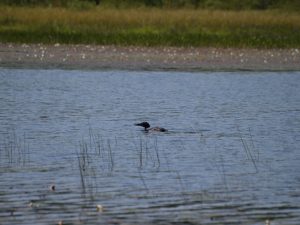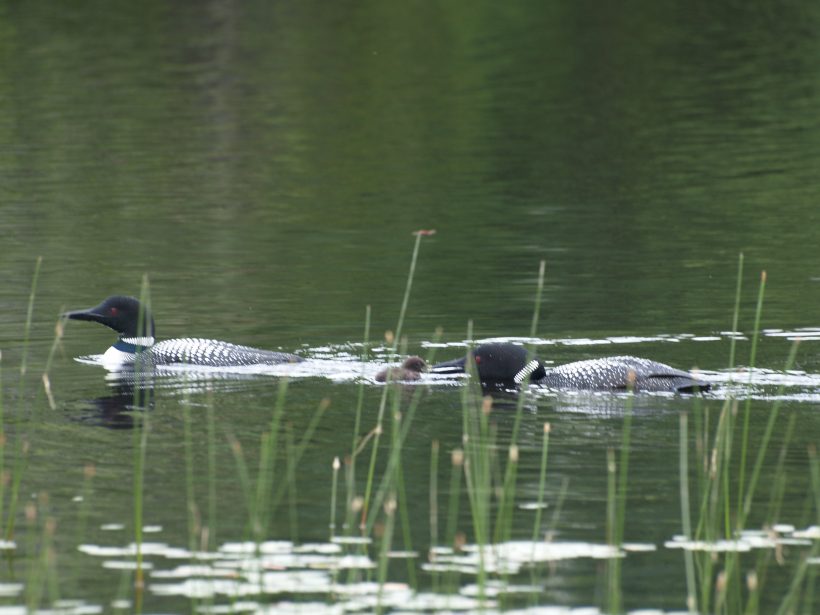ABOUT LOONS by Ralph Bice
From Wednesday, June 4, 1975
Couple of issues back I entitled a column Geese and Loons, and then found out I had a lot to say about geese and never did get around to saying anything about loons. So this will make up for what I missed in that story.
It is nice to see any of the birds back in the spring, even the crows. For some reason or other more mention is made of the Robin than any other bird, perhaps because it is so common and one bird that everyone knows. But to many of the people who spend a great deal of time in the woods every summer I think that the bird that means the most is the loon. Almost any and every lake has a pair of loons. Some of the larger lakes have a number of pairs, but I do not recall seeing two loons nest in a close neighbourhood. But they do nest in the same spot for many years, then for some reason move on to another location.
Years ago on that little island in David Lake there was a loon’s nest, a gull’s nest and a black duck nest. Nests are close to water so an adult can easily waddle out of the water and onto the nest during incubation. According to ‘Birds of Canada’, by Earl Godfrey, both adults take turns in hatching the eggs over a period of twenty-nine days. Mr. Godfrey refers to them as Order Gaviiformes. It is much easier to call them loons.

Years ago they were often referred to as “The Great Northern Diver”. Anyone who has watched them in and on the water will understand why they should be called divers.
One thing I have noticed over the years is that loons like to visit. On some of the larger lakes it will be noticed that a loon or perhaps a pair of loons will be sitting offshore. Suddenly another loon will appear flying in from some other lake. The others will arrive and I have counted as many as thirty-two loons in one gathering. (Circa 1970 in August I saw a huge raft of loons too numerous to count on Diamond Lake in Temagami.-Ed.)
They swim about, dive a bit, and if it is quiet there are times you can hear a noise like a slight murmur, almost as if they were carrying on a conversation. Then, after a short stay, one will remember (perhaps like husbands they had been sent on an errand and were unavoidably deterred and head for home.) But this happens so many times. And it is always interesting to see them come in a for a landing, or when taking off.
The loon we see is called the Common Loon and it is found in most of Canada. Their nesting area takes in all the Provinces but few in the Territories. They winter somewhere in the south as they must have water. Mrs. B. told me when she returned from a trip to Florida that she saw a number of loons swimming in the ocean but was not certain of the type. Nor did she hear them call.
We do have four different loons in Canada. The most common is our loon but there are three species that breed in the Arctic. They are the Yellow Billed Loon and this one is a bit larger than ours. Their markings are a bit different and of course a yellow beak.
Then there is the Arctic loon. This is a bit smaller and bit lighter in colouring. Their nesting range covers an area a bit further south than the Yellow Bill but still further north than the Common Loon.
Last is the Red Throated Loon. This too is quite a bit smaller than the Common Loon, and the male has a decided red throat. These birds nest in the Arctic. This includes the Territories and the Yukon but the map shows them almost as far as there is land even in Labrador and Newfoundland.
I believe in 1956 that there is a loon cross of the Common and Yellow Bill in a museum.
Loons in the far north have no fishermen to thrill at the sound of the first call in the spring. (Remarkably, as soon as the ice leaves a lake the loons immediately appear magically. –Ed)

Note: Annual Loon surveys by Birds Canada indicate that the Common Loon is being challenged by habitat loss, changing weather patterns and undoubtedly a host of other negative variables. – Ed.
